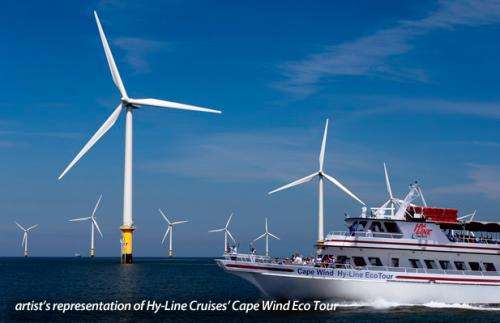January 2, 2014 weblog
Cape Wind, Siemens agree to Siemens turbines for offshore wind farm

(Phys.org) —Siemens last month inked a deal with the Cape Wind project that could be a significant step to advance wind farm activity in the United States. The plant is to operate in New England, on Horseshoe Shoal, an area of water toward the center of Nantucket Sound, Massachusetts. This would be America's first offshore wind farm, capable of powering on average three-quarters of the Cape and Islands with renewable energy. The wind turbines are to be spaced six to nine football fields apart. Siemens' role is major and comes in three parts. Siemens will provide the wind turbines; an electric service platform (ESP) positioned toward the center of the wind farm site, transforming voltage of the electricity produced by the turbines; and a service agreement for the first 15 years of commercial operations.
Siemens will supply 130 3.6-megawartt offshore turbines; in average winds the turbines, with combined capacity, will generate enough electricity for about three-quarters of Cape Cod and its islands. Randy Zwirn, Siemens Energy CEO, told Bloomberg, "This is really the first offshore wind project of any significance anywhere in the U.S." Also according to Bloomberg, Zwirn said that Siemens will most likely be an investor in the project.
Outside Siemens, the Cape deal is also seen as a door-opener for wind farms in the United States, at least from a business perspective, as a catalyst for a domestic wind industry and supply chain. The wind industry already has a substantial stronghold in Europe. As CleanTechnica said, other parts of the world such as the UK, Belgium, and Denmark as well as China have been active in pursuing offshore wind initiatives, yet "the US industry has been practically comatose, with just a couple of demonstration-scale projects to its credit. Cape Wind is going to change all that."
One of the reasons the offshore wind industry in the US has not matched its wind power potential has been opposing groups' objections to "visual pollution" and harm to birds, just two of the arguments that have been used against such initiatives. Yale Environment 360, a publication of the Yale School of Forestry and Environmental Studies, noted in September how "Offshore wind power in the U.S. has struggled mightily to rise from the waves, even as other renewable energy industries have steadily grown." They also noted daunting hurdles identified by analysts, including the higher cost of building offshore wind farms, the expense of connecting them to the onshore grid, and the lack of incentives and energy targets that supported the growth of Europe's offshore wind energy sector. Nonetheless, the Cape Wind project is moving ahead and the Siemens agreement for 130 turbines is bolstering confidence that the project will get under way. In a note of confidence, Siemens topped its December press release announcing the agreement with the wording, "Contract marks launch of Offshore Wind industry in America."
According to the Cape Wind site, "Cape Wind has secured all if its Federal and State permits in addition to a 25-year commercial lease from the U.S. Department of Interior. "
More information:
www.capewind.org/index.php
cleantechnica.com/2013/12/25/m … ect-kicks-high-gear/
e360.yale.edu/feature/will_off … _us_east_coast/2693/
© 2014 Phys.org













